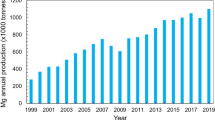Abstract
Vickers micro-indentation tests have been performed in the temperature range 20 to 420° C on the {0 0 1} surfaces of germanium crystals of three different dopings: “intrinsic”, heavily doped p-type and heavily doped n-type. Indentation sizes, dislocation rosette sizes and median/radial crack lengths were measured. Rosette sizes were found to depend strongly on doping, being respectively larger and smaller than in intrinsic material for n-type and p-type specimens, over the temperature range 20 to 420° C. This result correlates well with dislocation velocity measurements in germanium. Indentation size (hardness) was found to vary with doping above ~ 300° C, hardness increasing from n-type through intrinsic to p-type material. Crack lengths, as a function of temperature, showed a sharp transition (to much shorter crack lengths) at a well-defined temperature; this ductile/brittle transition temperature was found to depend on doping, being lowest for n-type (~ 290° C) and highest for p-type (~ 400° C). This is the first observation of a relation between a fracture parameter and bulk electronic doping.
Similar content being viewed by others
References
J. R. Patel andA. R. Chaudhuri,Phys. Rev. 143 (1966) 601.
J. R. Patel andP. E. Freeland,Phys. Rev. Lett. 18 (1967) 833.
A. George andG. Champier,Phys. Status Solidi 53a (1979) 529.
H. L. Frisch andJ. R. Patel,Phys. Rev. Lett. 18 (1967) 784.
P. Haasen,Phys. Status Solidi 28a (1975) 145.
P. B. Hirsch,J. Physique Colloque 40 (1979) C6–117.
R. Jones,Phil. Mag. 42B (1980) 213.
S. B. Kulkarni andW. S. Williams,J. Appl. Phys 47 (1976) 4318.
P. B. Hirsch, in “Proceedings of the Symposium on Defects in Semiconductors”, edited by J. Narayan and T. Y. Tan (Elsevier/North-Holland, 1981) p. 257.
J. Rabier, P. Veyssiere andJ. L. Demenet,J. Physique Colloque 44 (1983) C4–243.
S. G. Roberts, P. Pirouz andP. B. Hirsch,ibid. 44 (1983) C4–75.
P. Pirouz andP. E. Freeland, unpublished work (1983).
B. Tuck,J. Mater. Sci. 10 (1975) 321.
K. Sumino andH. Hasegawa,Trans. Jpn. Inst. Metals 9 (1968) 749.
K. Wessel andH. Alexander,Phil Mag. 35 (1977) 1523.
V. G. Eremenko andV. I. Nikitenko,Phys. Status Solidi 14a (1972) 317.
S. S. Chiang, D. B. Marshall andA. G. Evans,J. Appl. Phys. 53 (1982) 312.
E. H. Yoffe,Phil. Mag. 46A (1982) 617.
B. R. Lawn andR. Wilshaw,J. Mater. Sci. 10 (1975) 1049.
B. R. Lawn andD. B. Marshall,J. Amer. Ceram. Soc. 62 (1979) 347.
S. M. Hu,Appl. Phys. Lett. 31 (1977) 139.
Author information
Authors and Affiliations
Rights and permissions
About this article
Cite this article
Roberts, S.G., Pirouz, P. & Hirsch, P.B. Doping effects on indentation plasticity and fracture in germanium. J Mater Sci 20, 1739–1747 (1985). https://doi.org/10.1007/BF00555279
Received:
Accepted:
Issue Date:
DOI: https://doi.org/10.1007/BF00555279




